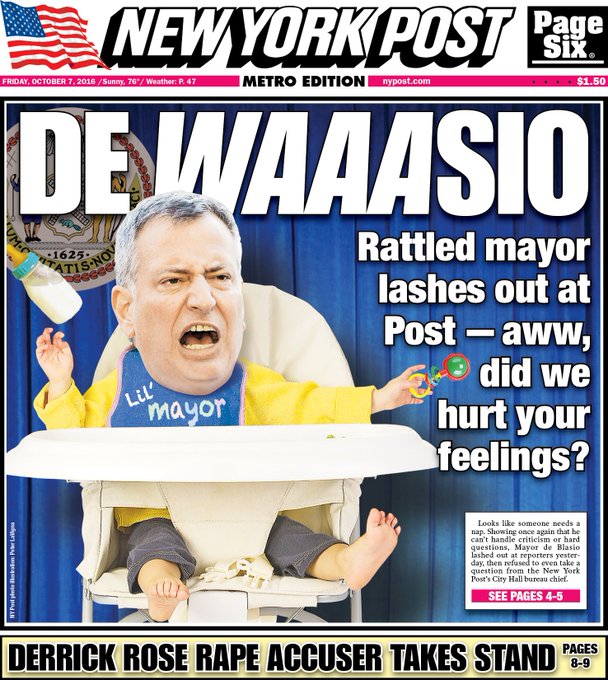The idea that this kind of singling out of press members by politicians is new and especially catastrophic is odd. Remember de Blasio and Obama doing the same?
At his first press conference since winning the election, President-elect Donald Trump made news by making the media the news. He called BuzzFeed, which published an unverified dossier of unclear provenance on Trump Tuesday, “a pile of garbage,” and refused to take a question from CNN’s Jim Acosta, calling the cable news network “fake news.” CNN had also published a piece on the report BuzzFeed published, but without the specific allegations included.
Reaction was swift and hyperbolic, characterized by this tweet from Vox’s Liz Plank.
Trump refusing to take a question because the outlet wrote a negative story is the beginning of the end of freedom of press.
I don’t think it’s productive to attempt to kick news organizations out of a press conference or bar them from coverage (full disclosure: I work for CNN as a contributor), although the president-elect can and absolutely should bat down questions he thinks are unfair. But the idea that this kind of singling out of press members by politicians is new and especially catastrophic is odd, especially considering there was a high-profile incident exactly like this at the epicenter of the media universe in October.
The media’s hometown Democratic Mayor Bill de Blasio, upset with New York Postcoverage of his administration, refused to recognize the paper’s City Hall reporter Yoav Gonen, getting into a verbal tussle as Gonen repeatedly tried to get his attention.
“You can keep calling all you want. I’m calling on real media outlets. You can keep trying, man,” he said, adding, “I’ve got no use for a right-wing rag that attacks people who are good public servants and tries to undermine their reputations.”
The New York Times covered the incident at the time, calling it a “very public and dismissive display…extraordinary in the history of antagonism between City Hall and the press.” The Post pushed back in Post fashion.
Tomorrow's cover: Thin-skinned de Blasio directs tantrum at a Post reporter http://nyp.st/2dwpciF
Maybe it’s a New York thing. But then how to explain the Obama White House’s feud with Fox News, which went far enough for other mainstream outlets to report it as a feud and step in on Fox’s behalf?
‘FOX News often operates almost as either the research arm or the communications arm of the Republican party,’ said Anita Dunn, White House communications director.‘If media is operating basically as a talk radio format, then that’s one thing, and if it’s operating as a news outlet, then that’s another,’ Mr. Obama said.And the White House has gone beyond words, reports CBS News senior political correspondent Jeff Greenfield. Last Sept. 20, the president went on every Sunday news show – except Chris Wallace’s show on FOX. And on Thursday, the Treasury Department tried to exclude FOX News from pool coverage of interviews with a key official. It backed down after strong protests from the press.‘All the networks said, that’s it, you’ve crossed the line,’ said CBS News White House correspondent Chip Reid.
The White House Press Association also sent President Obama a list of press freedom demands in 2015 after seven years of snubs,Pete Souza photos, and access problems:
The White House Correspondents’ Association, the organization that represents hundreds of reporters who cover the presidency, is crafting an extensive list of press freedom rules that it wants the White House to adhere to — following an incident in which President Obama kept reporters out of a meeting with Mormon leaders.‘The principle of the full [White House press] pool is so important to us that we’re working to address it in a set of written practices we’d like this and future administrations to follow,’ Association President Christi Parsons said in a statement to the Washington Examiner media desk. ‘We’ve been working on that document for almost a year now and will have more to say about it when we release it later this spring.’
There was also the time the Obama adminstration named Fox national reporter James Rosen a co-conspirator in violating the Espionage Act so they could spy on his phone records, whereabouts, and personal emails. Or the time the Obama administration seized two months of AP reporters’ phone records. Also, don’t forget the time Obama booted three newspapers’ reporters from his campaign plane because he didn’t like their coverage. So, there’s that.
In light of all this, perhaps we shouldn’t pretend Sean Spicer pointing a finger at a reporter is the end of press freedom. Many of Trump’s tactics will be new, and some probably genuinely threatening to press freedom. I genuinely want the press to be vigilant about any president, which is why I didn’t like that Obama’s first piece of advice to Trump at their in-person meeting was, “Don’t answer any questions when they start yelling at you.” This is one area where we don’t need Trump learning any tricks from Obama.
Mary Katharine Ham is a senior writer at The Federalist.



No comments:
Post a Comment